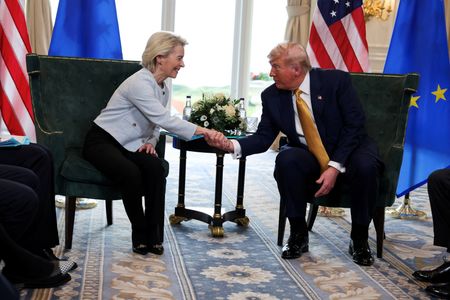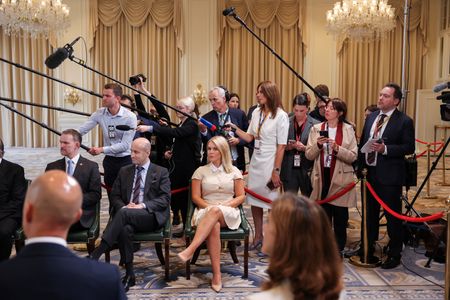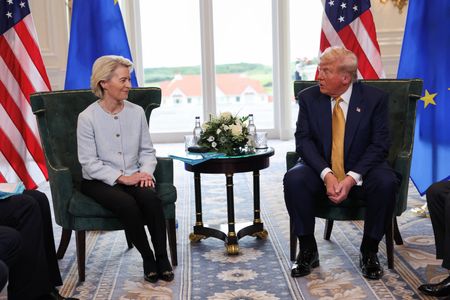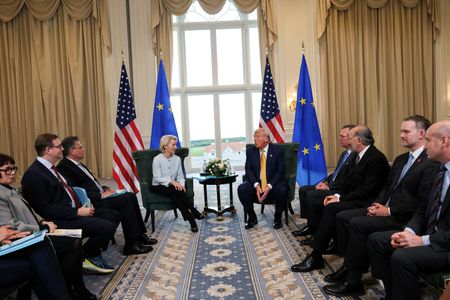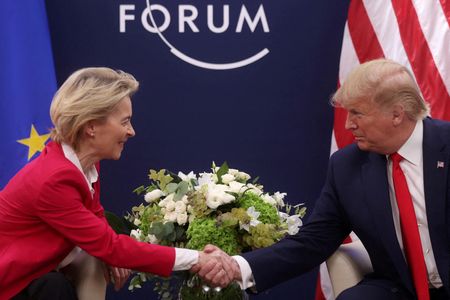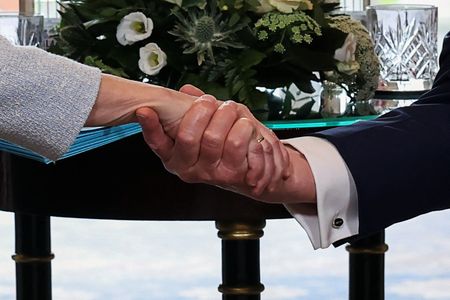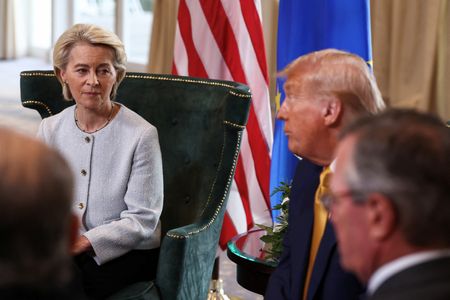By Andrew Gray and Andrea Shalal
TURNBERRY, Scotland (Reuters) -The United States struck a framework trade deal with the European Union on Sunday, imposing a 15% import tariff on most EU goods, but averting a spiralling battle between two allies which account for almost a third of global trade.
The announcement came after European Commission President Ursula von der Leyen travelled for talks with U.S. President Donald Trump at his golf course in western Scotland to push a hard-fought deal over the line.
“I think this is the biggest deal ever made,” Trump told reporters after an hour-long meeting with von der Leyen, who said the 15% tariff applied “across the board”.
“We have a trade deal between the two largest economies in the world, and it’s a big deal. It’s a huge deal. It will bring stability. It will bring predictability,” she said.
The deal, which also includes $600 billion of EU investments in the United States and $750 billion of EU purchases of U.S. energy over Trump’s second term, will indeed bring clarity for EU companies.
Even so, the baseline 15% tariff will be seen by many in Europe as a poor outcome compared with the initial European ambition of a zero-for-zero tariff deal, although it is better than the threatened 30% rate.
German Chancellor Friedrich Merz welcomed the deal, saying in a statement that a trade conflict had been averted that would have hit Germany’s export-driven economy and its large auto sector hard.
But Bernd Lange, the German Social Democrat who chair’s the trade committee of the European Parliament, said he was “quite critical” because the tariffs were imbalanced and the pledged $600 billion of investment would likely come at the expense of EU industry.
The euro rose around 0.2% against the dollar, sterling and yen within an hour of the deal’s being announced.
MIRROR OF JAPAN DEAL
The deal mirrors key parts of the framework agreement the United States clinched with Japan last week.
“We are agreeing that the tariff … for automobiles and everything else will be a straight-across tariff of 15%,” Trump said. That rate will not, however, apply to steel and aluminium, for which a 50% tariff will remain in place, although von der Leyen said it would be cut and replaced with a quota system.
Von der Leyen said the rate also applied to semiconductors and pharmaceuticals, and there would be no tariffs from either side on aircraft and aircraft parts, certain chemicals, certain generic drugs, semiconductor equipment, some agricultural products, natural resources and critical raw materials.
“We will keep working to add more products to this list,” she said, adding that the situation on spirits was still to be established.
Eric Winograd, chief economist at AllianceBernstein in New York, noted the similarity with Japan’s U.S. deal.
“We will need to see how long the sides stick to the deal. From a market perspective, it is reassuring in the sense that having a deal is better than not having a deal,” he said.
Trump, who is seeking to reorder the global economy and reduce decades-old U.S. trade deficits, has so far reeled in agreements with Britain, Japan, Indonesia and Vietnam, although his administration has failed to deliver on a promise of “90 deals in 90 days.”
He has periodically railed against the European Union, saying it was “formed to screw the United States” on trade.
Arriving in Scotland, Trump said the EU wanted “to make a deal very badly” and said, as he met von der Leyen, that Europe had been “very unfair to the United States”.
His main bugbear is the U.S. merchandise trade deficit with the EU, which in 2024 reached $235 billion, according to U.S. Census Bureau data. The EU points to the U.S. surplus in services, which it says partially redresses the balance. Trump also talked on Sunday about the “hundreds of billions of dollars” that tariffs were bringing in.
On July 12, Trump threatened to apply a 30% tariff on imports from the EU starting on August 1, after weeks of negotiations with the major U.S. trading partners failed to reach a comprehensive trade deal.
The EU had prepared countertariffs on 93 billion euros ($109 billion) of U.S. goods in the event there was no deal, and Trump had pressed ahead with 30% tariffs.
Some member states had also pushed for the bloc to use its most powerful trade weapon, the anti-coercion instrument, to target U.S. services in the event of a no-deal.
(Reporting by Andrea Shalal and Andrew Gray in Turnberry, Richard Lough in Paris, Susan Heavy in Washington, Jan Strupzewski, Sudip Kar-Gupta, Julia Payne and Philip Blenkinsop in Brussels; writing by Philip Blenkinsop; Editing by Alexandra Hudson, Ros Russell and Leslie Adler)

